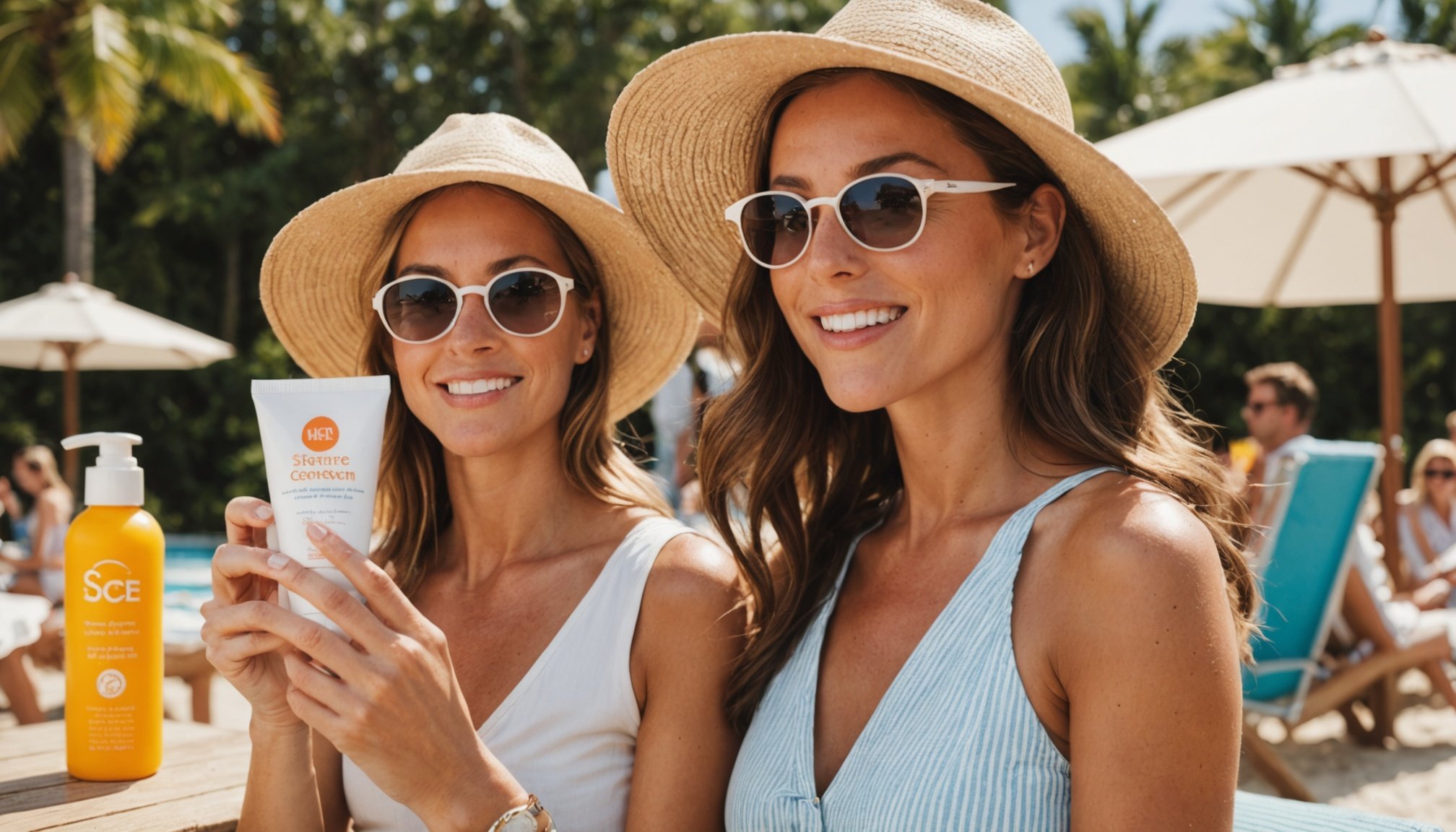Understanding Skin Types
Understanding your skin type is pivotal for selecting the right skincare products, particularly sunscreen. Skin types are generally classified into five categories: normal, dry, oily, combination, and sensitive. Each type has distinct characteristics, leading to different skincare needs.
Normal skin types are typically well-balanced and may not pose much trouble. Dry skin, characterized by flaking and tightness, requires moisturizing formulas to maintain hydration. In contrast, oily skin often experiences excess sebum and shine, necessitating lightweight, non-comedogenic products to prevent clogged pores. Combination skin displays mixed traits, usually oily in the T-zone (forehead, nose, chin) and dry elsewhere. Sensitive skin is prone to irritation and redness, requiring gentle formulations without harsh chemicals.
In the same genre : Transform Your Daily Beauty Routine with These Eco-Friendly Practices
Recognizing your skin type is essential for choosing effective sunscreens since each type responds differently to sun exposure. For example, oily skin may benefit from oil-free, matte-finish sunscreens, while dry skin performers need hydrating, creamy solutions. Sensitive skin is more susceptible to sun damage, meaning broad-spectrum, mineral-based sunscreens offer better protection. Understanding your skin’s classification enhances your ability to select products that support its unique needs and protect against sun damage.
The Importance of SPF
Understanding the significance of SPF is crucial in mitigating the effects of harmful UV radiation. SPF, or Sun Protection Factor, represents how well a sunscreen can protect the skin from sun’s ultraviolet rays. The numbers following SPF—such as SPF 30 or SPF 50—indicate how much time the sunscreen will protect your skin compared to no sunscreen. For instance, if skin would normally redden after 10 minutes in the sun, SPF 30 would theoretically allow for 300 minutes without burning.
Also to read : Create Your Ideal Home Yoga Sanctuary: Tips for Ultimate Comfort and Focus
Different SPF levels cater to various skin protection needs. Higher SPF numbers provide greater protection against UVB rays, but it is important to choose the SPF level based on your skin type, exposure time, and conditions like altitude and latitude. While SPF 15 is suitable for daily use when spending limited time outdoors, an SPF 50 is advised for prolonged outdoor activities.
Despite its importance, SPF usage is rife with myths. A common misconception is that SPF 100 offers double the protection of SPF 50, when in reality, the difference is marginal. Another myth is that once applied, you are protected all day; however, reapplication every two hours is essential for maintaining effectiveness, especially after swimming or sweating. Understanding these nuanced elements of SPF can help in making informed decisions around sun protection.
Choosing the Right Sunscreen
Selecting the perfect sunscreen requires understanding your unique needs and preferences. The key factors to consider are the ingredients, formulation, and sun protection factor (SPF). Chemical sunscreens absorb UV rays and convert them into heat, thanks to active ingredients like avobenzone. In contrast, physical sunscreens use zinc oxide or titanium dioxide to reflect UV rays away from the skin.
Skin compatibility is vital when deciding between chemical and physical sunscreens. For sensitive skin, physical sunscreens are generally recommended due to their lesser likelihood of causing irritation. On the other hand, chemical sunscreens tend to be lightweight and more suitable for everyday use.
Product recommendations are plentiful, yet tailored choices ensure the best outcomes. For oily skin, a gel-based sunscreen can prevent additional shine. Meanwhile, dry skin may benefit from a cream-based option that provides extra moisture. Normal skin types usually enjoy flexibility and can choose based on personal preference and activity level.
Ultimately, choosing a sunscreen hinges on your skin type and outdoor exposure. By factoring in these considerations, you can ensure your skin remains protected, healthy, and comfortable all year round.
Ingredients to Look For
When choosing skincare products, understanding beneficial ingredients and those that may cause skin irritants is crucial. Commonly beneficial ingredients recognized in sunscreens include zinc oxide and titanium dioxide. These are physical barriers that sit on the skin’s surface, blocking harmful UV rays effectively. Zinc oxide is known for its broad-spectrum protection, while titanium dioxide works well for those with sensitive skin due to its gentle properties.
Antioxidants such as Vitamin E and C are also key beneficial ingredients. They help neutralize free radicals caused by sunlight, reducing signs of aging. By incorporating these into your daily routine, your skin can retain its youthful glow.
However, some ingredients might pose challenges for individuals with skin sensitivities. Be wary of parabens, fragrances, and alcohol, as these may irritate sensitive skin and trigger adverse reactions. Understanding this can enable you to avoid unnecessary discomfort.
To ensure a product’s suitability, reading sunscreen labels effectively is essential. Look for active and inactive ingredients and familiarize yourself with terms like “broad-spectrum” or “non-comedogenic.” This precision will guide you in selecting the appropriate products to suit your skin’s needs, providing both efficacy and comfort.
Application Techniques and Tips
Applying sunscreen can seem straightforward, but proper sunscreen application methods ensure maximum protection and effectiveness. To start, apply sunscreen generously about 15-30 minutes before going outdoors. This allows your skin to absorb the product fully, providing effective protection.
Frequency is crucial to maintaining effectiveness. Reapply every two hours, or more frequently after swimming, sweating, or towel drying. Even on cloudy days or when indoors near windows, UV rays can penetrate, necessitating consistent sunscreen use.
Different activities and skin types require varying application needs. If you’re engaging in water sports or prone to sweating, choose water-resistant sunscreens and reapply more often to maintain protection.
Some areas are often neglected, like the ears, back of the neck, and tops of feet. Ensure full coverage by taking extra care with these often-forgotten spots, especially if you have short hair or open footwear.
Techniques for optimal application include using an adequate amount—about a teaspoon for the face and a shot glass’s worth for the body. Rub the product in thoroughly and consider using sprays for hard-to-reach areas.
Focusing on these tips will help you ensure your sunscreen offers its best effectiveness and protection.
Visual Aids and Resources
Understanding sunscreen and skin type can be complex. Using comprehensive infographics and charts can simplify this process, offering clear, concise, and visual information.
Suggested Visual Models
Infographics can effectively illustrate different skin types, SPF ratings, and their benefits. For example, a chart showing which SPF level is appropriate for various UV indexes helps clarify decision-making. Educational tools, such as animations explaining how sunscreens work on different skin types, enhance understanding further, turning static facts into engaging learning experiences.
Credible Resources
Relying on credible sources is crucial when delving into sunscreen and skin health topics. Trusted organizations, such as the Skin Cancer Foundation and the American Academy of Dermatology, offer valuable insights. They provide well-researched articles and guidelines to help consumers make informed choices about sunscreens.
Interactive Tools
For those looking to delve deeper, interactive tools can be invaluable. Apps that determine skin type or suggest suitable sunscreen options based on personal habits are available. These user-friendly resources recommend products tailored to individual needs, transforming the often-confusing sunscreen choice into a personalized experience. Thus, blending educational tools with practical applications enhances both understanding and usability.










